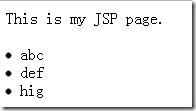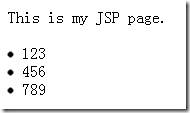Spring與Struts2整合
Struts2與Spring整合後,可以使用Spring的配置檔案applicationContext.xml來描述依賴關係,在Struts2的配置檔案struts.xml來使用Spring建立的bean。
1、匯入依賴包
除了匯入Struts2和Spring的核心庫之外,還要匯入commons-logging和struts2-spring-plugin包,否則啟動會出異常
2、web.xml的配置
既然有Struts2,核心攔截器的配置是不可少的
<filter> <filter-name>struts2</filter-name><filter-class>org.apache.struts2.dispatcher.FilterDispatcher</filter-class> </filter> <filter-mapping> <filter-name>struts2</filter-name> <url-pattern>/*</url-pattern> </filter-mapping>
通過配置ContextLoaderListener監聽器,使容器啟動時,自動載入applicationContext配置,
因為它實現了ServletContextListener這個介面,容器啟動時會自動執行它實現的方法。
<listener> <listener-class>org.springframework.web.context.ContextLoaderListener</listener-class> </listener>
預設情況下,會載入WEB-INF/applicationContext.xml這個檔案,我們可以通過配置contextConfigLocation引數改變配置檔案的路徑
<context-param> <param-name>contextConfigLocation</param-name> <param-value>WEB-INF/classes/applicationContext.xml</param-value> </context-param>
以上配置均在web.xml檔案的<web-app></web-app>區域
3、測試類
在瀏覽器請求一個Action方法,在Action方法內向一個物件請求一個List,然後轉到index.jsp頁面,在頁面中輸出Action請求到的List。
通過Spring依賴配置,控制Action請求的物件。
首先要編寫一個介面,Action方法依賴這個介面,通過呼叫介面中的方法獲取List
public interface IocTestInterface { public List getList(); }
下面編寫Action類,這個類繼承ActionSupport類,並覆蓋其中的execute方法,
execute方法執行時,呼叫實現了上述介面物件的getList方法獲取List
public class IocAction extends ActionSupport { private IocTestInterface iti; private List list; public List getList() { return list; } public void setList(List list) { this.list = list; } public IocTestInterface getIti() { return iti; } public void setIti(IocTestInterface iti) { this.iti = iti; } public String execute() throws Exception { this.setList(iti.getList()); return super.execute(); } }
編寫用來顯示執行結果的jsp檔案
遍歷list,並將每個元素作為一行來顯示
<%@ page language="java" import="java.util.*" pageEncoding="ISO-8859-1"%> <%@ taglib prefix="s" uri="/struts-tags" %> <!DOCTYPE HTML PUBLIC "-//W3C//DTD HTML 4.01 Transitional//EN"> <html> <body> This is my JSP page. <br><br> <s:iterator value="list" id="current"> <li><s:property value="current"/></li> </s:iterator> </body> </html>
系統的結構就是這樣。下面編寫兩個實現IocTestInterface介面的類,用來提供資料
public class IocTestImpl implements IocTestInterface { public List getList() { List l = new ArrayList(); l.add("abc"); l.add("def"); l.add("hig"); return l; } }
public class IocTest2Impl implements IocTestInterface { public List getList() { List l = new ArrayList(); l.add("123"); l.add("456"); l.add("789"); return l; } }
4、編寫applicationContext.xml配置依賴關係
<beans xmlns ="http://www.springframework.org/schema/beans" xmlns:xsi ="http://www.w3.org/2001/XMLSchema-instance" xsi:schemaLocation ="http://www.springframework.org/schema/beans http://www.springframework.org/schema/beans/spring-beans-2.0.xsd"> <bean name="IocAction" class="sy.struts2.ioc.IocAction"> <property name="iti"> <bean class="sy.struts2.ioc.IocTestImpl"></bean> </property> </bean> </beans>
檔案配置了id為IocAction的bean,路徑為剛剛編寫的Action類的路徑,其中iti物件(請求資料的物件)配置為IocTestImpl(這裡使用了匿名bean)
5、編寫struts.xml配置檔案
首先要告知Struts 2執行時使用Spring來建立物件
在<struts></struts>區域加入以下配置
<constant name="struts.objectFactory" value="spring" />
建立package並配置Action
<package name="hs" extends="struts-default"> <action name="ioc" class="IocAction"> <result>/index.jsp</result> </action> </package>
6、釋出並執行
修改spring配置檔案applicationContext.xml中配置
<bean name="IocAction" class="sy.struts2.ioc.IocAction"> <property name="iti"> <bean class="sy.struts2.ioc.IocTest2Impl"></bean> </property> </bean>
只是將注入到IocAction中的IocTestImpl修改為IocTest2Impl,也就是使用了另一個實現了IocTestInterface介面的類
重啟伺服器,再次開啟剛才的地址
這也就是spring的“控制反轉”


